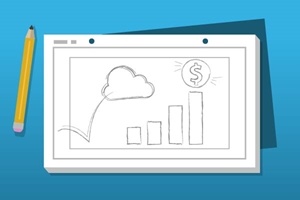Back in the 1930s, animators at Disney pioneered the now-common practice of storyboarding. This process involves visually planning out a motion picture (such as a cartoon or an action flick) before it is actually produced. The storyboard itself is a collection of numbered frames, arranged side by side in sequence, showing what will go into each of the production's scenes.
Why do entertainment firms rely on storyboards? These devices help translate texts (i.e., scripts) into images, serve as guides for video editors and ultimately save everyone a lot of time during revisions. In these ways, storyboards are like other types of detailed planning, such as group calendaring and chat, or companywide budgeting and forecasting.
Indeed, imagining a major media project without a storyboard is like imagining a modern business without a proper set of financial software tools. Just as animators could fall behind schedule without this shared point of reference, finance teams can and do get sidetracked without access to accurate forecasts, reports and cost information.
A story without a storyboard: The challenges of immature forecasting processes
What can happen when an organization's forecasting processes are not fully fleshed-out? Its finance team can soon find itself in a tough spot, characterized by:
- Routinely missing its guidance estimates, which leads to high costs. For example, a logistics company might misjudge its total level of customer demand, resulting in much steeper than expected freight expenses. This situation can be caused by forecasts that do not use current data.
- Wrangling with unreliable budgets. A company with, say, many branch offices could struggle to stay on top of tons of different Excel sheets, each holding its own budget that is almost impossible to change in a timely way. Reconciling and cleaning up these budgets can take weeks.
- Failing to effectively scale or plan ahead. Whether it involves supporting multiple currencies, keeping IT costs in check, producing rolling forecasts or modeling numerous what-if scenarios, relying on Excel or legacy tools is a poor recipe for growth. Manual processes and data entry errors greatly impede any effort to increase the organization's reach.
In some cases, the productivity-sapping shortcomings of immature (and heavily manual) forecasting processes are only fully apparent after the fact, once a superior solution such as the Adaptive Insights Suite has been implemented with the help of an experienced partner. DHL, for instance, saved the equivalent of five entire weeks' worth of work for its finance department by upgrading to Adaptive Planning.
"Finance teams get sidetracked without access to proper forecasts."
Similarly, ZAGG trimmed $8 million from its freight charges thanks to more accurate rolling forecasts supported by four different Adaptive products. Automation of reporting also eliminated 24 days of manual report building each year. What else can cloud financial software bring to the table for organizations looking for more reliable budgets as well as prompt forecasts?

Budgeting and forecasting software can knock entire months' worth of work off your plate.
How cloud software drives business value
For animators and filmmakers, a storyboard brings structure to what would otherwise be a chaotic whirl of different ideas, visions and edits. A platform like Adaptive Insights does something similar for accountants and their colleagues. It:
- Boosts productivity: Planning and reporting cycles can be sped up, which frees up time for stakeholders to focus on value-added tasks.
- Provides higher quality insights: Up-to-date information can be presented in a visual, intuitive way that everyone can understand; financial performance is no longer obscure.
- Makes finance a strategic partner: Freed from rote tasks, finance can help with activities such as mergers and acquisitions. Budgeting and forecasting software can provide advanced scenario modeling to support more informed decision-making.
- Drives down costs: IT can save big on software licensing fees, hardware procurement and maintenance since the solution is delivered via a software-as-a-service model.
These benefits and many others can be unlocked by first upgrading your corporate performance management. From there, a partner such as Arxis can take your organization even further, by helping you get the most of your new budgeting and forecasting tools.
Arxis takes your specific needs into account and comes up with a plan that is an ideal solution to your particular challenges and requirements. Any complicated task will require top-notch planning, so why wait to move on from Excel? Adaptive Insights lets you visualize your finances in the same way a storyboard helps entertainment companies see what a project will look like, frame-by-frame.




